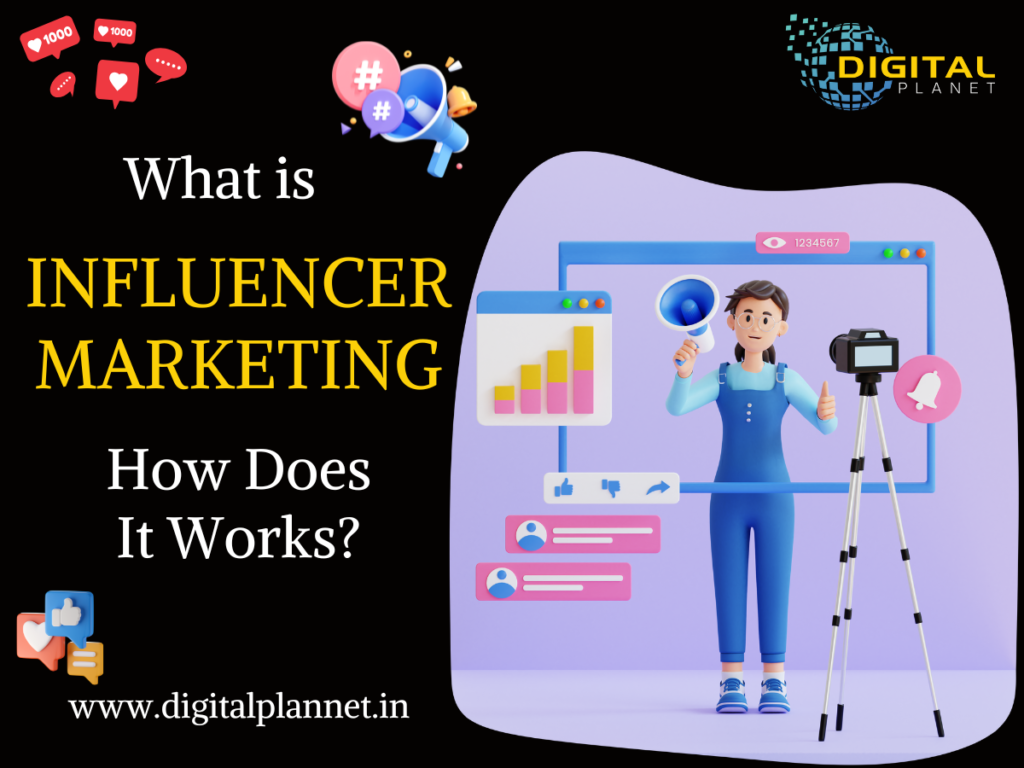What is Influencer Marketing and How Does it Work?

In today’s digital age, brands are constantly looking for innovative ways to reach their audiences and build stronger connections. Influencer marketing has emerged as one of the most effective strategies to achieve this. By partnering with influencers who have large, dedicated followers, businesses can extend their reach, build trust, and generate higher engagement. In this article, we delve deep into what influencer marketing is and how it works, offering valuable insights for brands looking to leverage this powerful marketing approach.
What is Influencer Marketing?
Influencer marketing is a form of social media marketing that involves endorsements and product placements from individuals who have a high level of influence over their followers, known as influencers. These individuals typically have a substantial, engaged following on platforms like Instagram, YouTube, TikTok, and Twitter. By sharing content related to a brand or product, influencers can impact the purchasing decisions of their followers, making influencer marketing a valuable tool for businesses.
Unlike traditional forms of advertising, which can sometimes feel impersonal or overly promotional, influencer marketing creates authentic and organic connections between brands and consumers. Influencers can present products in ways that align with their personal brand, creating genuine interest and trust among their audience.
Types of Influencers and Why They Matter?
Not all influencers are the same. To effectively use influencer marketing, brands must understand the different categories of influencers, as each type brings unique strengths.
1. Mega-Influencers: These influencers have millions of followers and are often celebrities or public figures. Mega-influencers can reach a vast audience, making them ideal for campaigns focused on brand awareness. However, they may lack the personal connection smaller influencers have with their followers.
2. Macro-Influencers: With followings ranging from 100,000 to 1 million, macro-influencers are well-known figures but not quite at the celebrity level. They offer a balance between reach and engagement, making them a popular choice for larger brands aiming to target specific demographics.
3. Micro-Influencers: Micro-influencers have followings between 10,000 to 100,000. They are often seen as highly relatable and trustworthy by their followers, creating strong engagement rates. Brands targeting niche audiences or aiming for authenticity find great value in working with micro-influencers.
4. Nano-Influencers: With fewer than 10,000 followers, nano-influencers have a highly engaged and loyal audience. They tend to have closer relationships with their followers, making their recommendations feel more personal and genuine. Nano-influencers are an excellent choice for small businesses or brands looking to build trust within a close-knit community.
How Does Influencer Marketing Work?
At its core, influencer marketing works by leveraging the trust that influencers have established with their audience. Here’s how it typically unfolds:
1. Finding the Right Influencer
Finding the right influencer is crucial to the success of any campaign. Brands often look for influencers whose audience aligns with their target demographics. This process may involve researching an influencer’s engagement rate, audience insights, and overall brand compatibility. Brands can find influencers through social media platforms, influencer marketing agencies, or specialized tools like BuzzSumo, HypeAuditor, or SocialBlade.
2. Defining Campaign Goals
Every influencer marketing campaign should have clearly defined goals. These may include increasing brand awareness, boosting product sales, generating user engagement, or driving website traffic. Establishing these goals allows brands to measure the campaign’s effectiveness and ROI accurately.
3. Creating a Collaborative Campaign Strategy
Once the influencer is chosen, brands collaborate with them to develop a strategy that aligns with both parties’ values. Influencers typically have creative freedom to present products in a way that resonates with their followers. Whether it’s through a product review, a tutorial, or a “day in the life” post, the goal is to create authentic and engaging content.
4. Tracking and Measuring Success
To evaluate the success of an influencer marketing campaign, brands use metrics such as reach, engagement, conversion rate, and follower growth. Tracking tools and platforms like Google Analytics, Sprout Social, and social media insights help brands gauge the effectiveness of the campaign.
Benefits of Influencer Marketing for Businesses
Influencer marketing offers numerous advantages for businesses, from increased brand visibility to improved customer trust.
1. Increased Reach and Brand Awareness
Influencers have followers across various demographics and locations, allowing brands to reach new and broader audiences. By working with influencers, companies can increase their brand visibility and introduce their products to potential customers who may not have discovered them otherwise.
2. Enhanced Credibility and Trust
When an influencer recommends a product, it often feels like advice from a friend, which can significantly boost credibility. Influencers have spent years building trust with their audience, and a brand endorsement from them feels authentic and reliable.
3. Higher Engagement Rates
Content created by influencers often generates higher engagement rates compared to traditional advertisements. This is because influencers create personalized content that resonates with their followers, prompting them to interact, comment, and share.
4. Cost-Effective Marketing
Influencer marketing can be more affordable than other advertising forms, especially when working with nano- and micro-influencers. Smaller influencers tend to have lower fees and higher engagement rates, making them cost-effective options for brands.
5. Improved SEO and Online Presence
Influencer marketing can also benefit a brand’s SEO strategy. When influencers link to a brand’s website or mention it on their social media profiles, it can improve the brand’s search engine rankings. The increased online visibility helps build an online presence that’s not only attractive to consumers but also beneficial to SEO.
Challenges and Risks in Influencer Marketing
While influencer marketing has significant benefits, it also comes with potential challenges that brands should consider.
1. Finding Authentic Influencers
In an era where follower counts can be artificially inflated, finding influencers with genuine followings is essential. Brands must conduct thorough research to ensure the influencer’s audience is real and engaged.
2. Ensuring Brand Alignment
Not all influencers align with every brand’s values or image. Mismatched partnerships can lead to backlash or tarnish a brand’s reputation. Brands should look for influencers who genuinely reflect their image and values.
3. Measuring ROI Accurately
Calculating the return on investment (ROI) for influencer marketing can be complex. Metrics such as engagement rates, website traffic, and sales conversions can help, but these are not always directly correlated. Brands must establish clear KPIs (Key Performance Indicators) and tracking methods to evaluate the campaign’s success.
4. Managing Compliance and Disclosure
Regulations around sponsored content and endorsements are becoming stricter. In many countries, influencers must disclose partnerships clearly, usually through hashtags like ad or sponsored. Brands must ensure their influencer partners comply with these regulations to avoid legal consequences.
Best Practices for Successful Influencer Marketing
To make the most of influencer marketing, businesses should adhere to best practices that enhance campaign success and minimize risks.
1. Prioritize Authenticity
Authenticity is the cornerstone of successful influencer marketing. Encourage influencers to present products in ways that feel natural and unforced. Followers are quick to spot insincerity, so it’s essential that influencers believe in the product they’re endorsing.
2. Set Clear Expectations
Open communication and clear guidelines ensure both parties understand their roles and deliverables. Setting expectations around posting schedules, content formats, and performance metrics can prevent misunderstandings and create a smoother workflow.
3. Build Long-Term Relationships
Brands can see more substantial results from long-term partnerships with influencers. This approach fosters a deeper relationship with the influencer’s audience and builds trust over time. Many brands are now moving towards ambassador programs, where influencers regularly promote products.
4. Diversify Influencer Choices
Using a mix of mega, macro, micro, and nano influencers can broaden a brand’s reach and effectiveness. Each influencer category offers unique benefits, and a diverse influencer strategy can yield better overall results.
5. Evaluate and Adjust Campaigns
After launching an influencer marketing campaign, brands should continuously monitor its performance. Analyzing metrics and feedback allows brands to identify areas for improvement and make adjustments for future campaigns.
Conclusion
Influencer marketing has transformed how businesses connect with audiences, offering a powerful way to build brand awareness, establish trust, and drive engagement. By working with influencers who have established credibility and authentic relationships with their followers, brands can reach potential customers in ways that feel genuine and personal. However, successful influencer marketing requires careful planning, a deep understanding of the target audience, and a strategic approach to selecting the right influencers and measuring outcomes.
As the digital landscape continues to evolve, influencer marketing remains a highly effective tool for businesses of all sizes aiming to create meaningful connections with their audiences. By leveraging the unique strengths of different types of influencers, setting clear goals, and fostering authentic partnerships, brands can maximize their impact and achieve lasting success.
Related Posts
- How to Remove Toxic Backlinks (Complete 2025 Guide)
- How to Identify Toxic Backlinks 2025: Ultimate Guide + 15 Expert Steps
- Best AI for Video Generation Free 2025: Ultimate Guide + Top Picks
- How to Get Invite Code for Sora 2 (2025): The Ultimate Step-by-Step Guide
- Influencer Marketing for Travel Industry 2025
